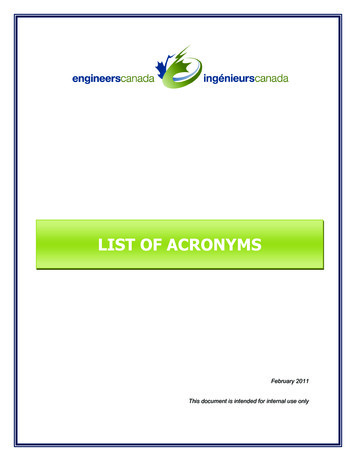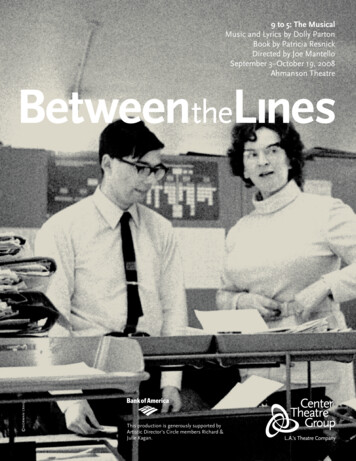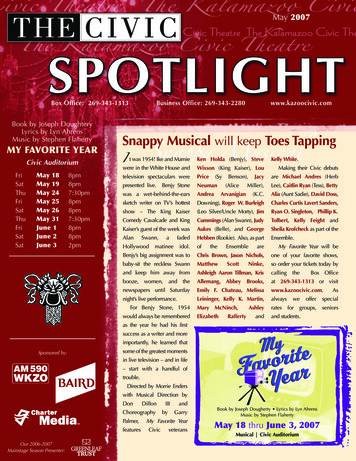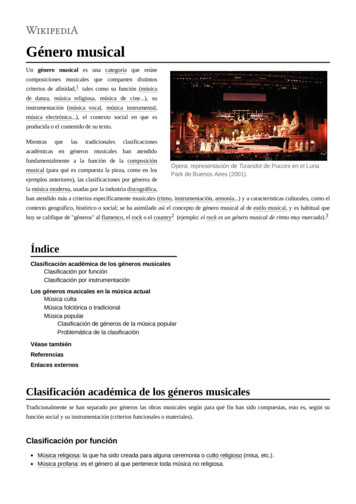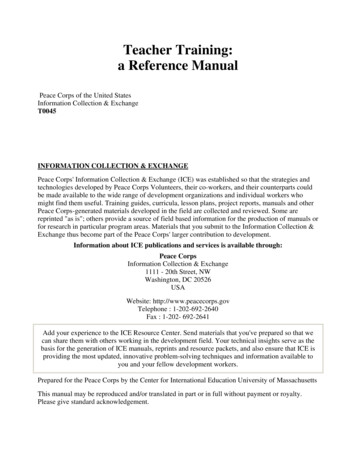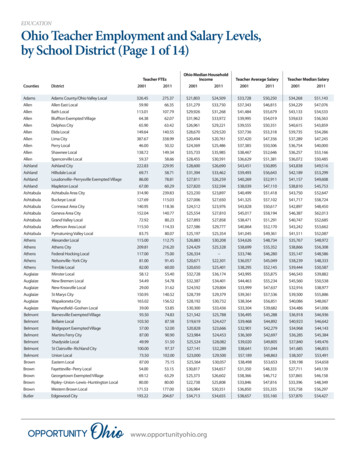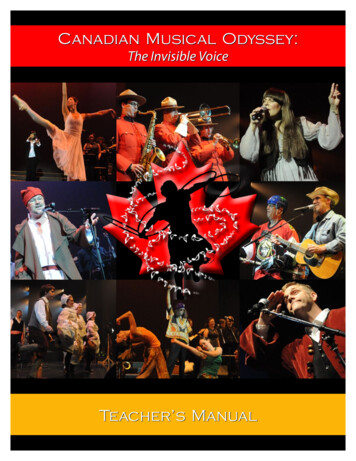
Transcription
Canadian Musical Odyssey:The Invisible VoiceTeacher’s Manual
Canadian Musical Odyssey: The Invisible Voice - Teacher’s ManualProud to sponsorCanadian Musical Odyssey.We’re working together withCanadian Musical Odysseyto make a difference inour communities.M04198 (0610)iwww.cmod.ca
Canadian Musical Odyssey: The Invisible Voice - Teacher’s ManualCANADIANMUSICAL Odyssey:The Invisible VoiceTeacher’s ManualCopyright Canadian Musical Odyssey, 2003 and 2010www.cmod.caii
Canadian Musical Odyssey: The Invisible Voice - Teacher’s ManualResearched and written by Deborah Davis (B.A., McGill) and NaomiVentura (B.A., B.Ed., University of Ottawa), with revisions by Dr. ElaineKeillor (Ph.D., University of Toronto, Chair, Canadian Musical HeritageSociety, Carleton University), and editorial revisions by Raissa Marks (B.Sc.,McGill), Louis Davis (D.C.S., B.C.L., LL.B., McGill) and Robert Fontaine.Copyright Canadian Musical Odyssey 2003 and 201024-21 Midland CrescentOttawa, ON, K2H 8P6Tel: 613-596-6843Web: www.cmod.caAll Rights Reserved.No part of this manual may be reproduced or transmitted in any formor by any means, electronic or mechanical, including photocopying,recording, or by any information storage and retrieval system, withoutpermission in writing from the publisher.Printed in Canada.The publisher has made every attempt to ensure copyright compliancein the use of all materials in this manual. If there is any oversight in thisregard, please contact the publisher at CMOD.iiiwww.cmod.ca
Canadian Musical Odyssey: The Invisible Voice - Teacher’s ManualACKNOWLEDGEMENTSCanadian Musical Odyssey would like to acknowledge the followingfor their help:Archie Alleyne - Executive Producer, E.O.J. ProductionsPeter Beaudoin for his research and for sharing his knowledgeProfessor Gerry Cammy – Professor of History, Heritage College and CFRARadio Talk Show HostClifford Ford – Clifford Ford ProductionsProfessor Chad Gaffield – Founding Director, Institute of Canadian Studies,University of OttawaMike Giunta - Music Director, CHEZ 106Sheila Hamilton - The Canadian Country Music AssociationBill King - The Jazz ReportMitchel Kitz - The Canadian Music CentreMark Miller - Jazz Historian, The Globe & MailMusic Division, National Library of CanadaNepean Public LibraryOttawa-Carleton District School BoardOttawa Public LibrarySOCAN, all the offices across the countrywww.cmod.caiv
Canadian Musical Odyssey: The Invisible Voice - Teacher’s ManualSPONSORSHIP ACKNOWLEDGEMENTSCanadian Musical Odyssey gratefully acknowledges the financial support of the Governmentof Canada through the Canadian Studies Program, (Department of) Canadian Heritage, and thesupport provided by our other sponsors for this project:This project has been supported by the Canadian Studies Program, Canadian Heritage; theopinions expressed do not necessarily reflect the views of the Government of Canada.CherunDesignvwww.cmod.caInc.
Canadian Musical Odyssey: The Invisible Voice - Teacher’s ManualForewordWhile a few observers have perceived a declining interest in history, others have been hardat work to respond to a growing demand for imaginative and innovative ways to learn aboutCanada’s past. The most successful of these efforts have gone well beyond the traditional focuson textbooks where students were expected to passively memorize information about certainevents and individuals. In the new approach, students are invited to become active learners byengaging diverse topics designed to enhance their understanding of the complexity and richnessof Canadian history.In creative and compelling ways, Deborah Davis and her colleagues are at the forefront ofsuch innovative efforts to support the study of Canada’s past. They have shown how musiccan stimulate, inspire and inform students about key social and cultural transformations inthe making of modern Canada. In recent years, I have had the pleasure of experiencing firsthand the excitement and engagement of students “tasting” Canada’s musical heritage, and myenthusiasm for this approach is the direct result of this experience. I saw students who wereobviously seeing Canadian history in new ways. They were, indeed, becoming active learnerswho were connecting with the past through their appreciation and wonder at the sounds andsights of our musical heritage.Thus, we are all indebted to Deborah Davis and her team for their splendid work that has made itincreasingly possible for students to learn about Canada’s past in ways that are truly compelling.Chad Gaffield, Ph.D., Professor of History, University Research Chair, Founding Director, Instituteof Canadian Studies, University of Ottawawww.cmod.cavi
Canadian Musical Odyssey: The Invisible Voice - Teacher’s ManualTable of ContentsACKNOWLEDGEMENTS ivForeword viIntroduction 1Indigenous Music 4Inuit Music 5First Nations Music 8Folk Music 14Newfoundland 16Prince Edward Island 17Nova Scotia and New Brunswick 17Quebec 19Ontario and the Prairies 23British Columbia 24Contemporary Folk Music 24Classical Music 26Military Music 27Opera 27‘Colas et Colinette’ or ‘Le Bailli dupé’ 28‘The Widow’ 28‘Leo, the Royal Cadet’ 29‘Louis Riel’ 30Orchestral and Chamber Music 31Classical Music in the 20th Century 32Country Music 34viiwww.cmod.ca
Canadian Musical Odyssey: The Invisible Voice - Teacher’s ManualRock and Pop Music 38Pop 39Rock 39Jazz Music 43Traditional and Dixieland Jazz 47Bebop 48Big Bands 48Third Stream 49Contemporary Jazz 49Fusion and Latin Jazz 49Avant Garde Music 49The Juno Awards 51Projects and Activities for Students 52Additional Resources 56Photo Sources 57Works Consulted 59Notes 60www.cmod.caviii
Canadian Musical Odyssey: The Invisible Voice - Teacher’s Manualixwww.cmod.ca
Canadian Musical Odyssey: The Invisible Voice - Teacher’s ManualIntroductionCanada’s music history is so rich and vast that it is impossible to give a comprehensive account of itwithout writing a multi-volume encyclopedia. This manual has been created to accompany CanadianMusical Odyssey’s live stage production of “A Musical Taste of Our Canadian Heritage/Notre patrimoinecanadien, une odyssée musicale ”. Even on its own, it offers valuable, introductory educational informationon Canada’s musical heritage for teachers. For your convenience, suggested classroom activities that areadaptable for most grade levels have been included at the end of this manual.In 1989, I founded Choonga Changa Productions to create live theatrical musical productions for children.This evolved into the creation of unique productions for schools that blended historical themes withdifferent musical genres.The first major new production of this type was “What is This Thing Called Jazz?”, a historical retrospectiveof the evolution of jazz. For this show, I also produced a 10-page teachers’ manual. Aside from manyschool productions, this show highlighted the Ottawa International Jazz Festival’s newly created FamilyDay for three years.The detailed research necessary to create that production was an enriching personal learning experience.I became increasingly aware of, and fascinated by, the important interrelated influences of jazz on Americanhistory (e.g. its influence on the breaking down of the colour barrier) and of the influences of historical,cultural, social and technological events on the development, progress and popularity of the music.With these things very much in mind, in 1998 I undertook the creation and production of a show entitled“A Musical Taste of Our Canadian Heritage”. My aim was to show the history of music in Canada and thehistory of Canada through music in an entertaining way that students would find not only educational, butalso appealing, moving, memorable and inspirational. Most of all, I wanted to do justice to the subject inlight of our tremendous heritage both on the musical and historical side and I wanted the students to feela deep sense of pride in their Canadian heritage with its multicultural origins.The project grew and became a fast paced, dynamic, and highly acclaimed, bilingual (and indeedmultilingual), 90 minute production that includes 50 performers, (including Aboriginal, Inuit and Métisperformers), over 80 pieces of music (mostly in overture, medley and excerpt style presentations), withalmost as many costume changes for the vocalists, dancers, actors and musicians.Both the show and this teacher’s manual were the culmination of many years of development and networkingand have received high praise in too many formal and informal reviews to mention here but some of whichcan be seen on our website. I have been assisted in these efforts in various ways at different times by theFederal Government (The Millennium Foundation and Canadian Heritage), The Royal Canadian MountedPolice, Ottawa Little Theatre, The University of Ottawa’s Institute of Canadian Studies, The Canadian MusicalHeritage Society at Carleton University, The City of Ottawa, SOCAN, Wall Sound and Lighting, Scholasticwww.cmod.ca1
Canadian Musical Odyssey: The Invisible Voice - Teacher’s ManualCanada, Yamaha Music, The Hudson’s Bay Foundation, The Musicians Association of Ottawa Hull, The OttawaCarleton District School Board, Parker Prins Lebano, Drache LLP, IBM Canada, Ottawa Arts Court Foundation,CTV Ottawa, Max Keeping, Professor Gerald Cammy, CFRA Radio, Printomatic, Tina and Company, EnviroCopies, Collective Cookie, Ottawa Jewish Historical Society, Barrett Palmer Models, Alan Dean Photography,e-PALS, A.K.A. Artists Management Ltd., Turtle Island Tourism Company, Aboriginal Experiences, The NationalLibrary and Archives Canada, The Ottawa Tourism and Convention Authority, CARFAC, Richard RobinsonAcademy of Fashion Design, Canadian Museum of Civilization Corporation, Cherun Design Inc., LietteBeaudoin, and dedicated cast and crew and volunteers too numerous to mention.Throughout the last ten years, however, there has been one supporter of this project who is owed a specialdebt of gratitude for their encouragement, advice, financial assistance and feedback - TD and especiallyCathy Jowsey, Manager Community Relations, TD Canada Trust and Alan Convery, National ManagerCommunity Relations, TD Bank Group.As of December, 2003, when this introduction was first written “A Musical Taste of Our Canadian Heritage”had been presented to over 12,000 students, educators and parents at the Adult High School and atCentrepointe Theatre in Ottawa. The show was also presented at an international conference entitled“Learning As A Lifelong Tool” convened by HRDC and the OECD at the Chateau Laurier Hotel in Ottawa inDecember of 2000. It was also a feature evening presentation for over 100,000 people on Parliament Hillfor Canada Day July 1, 2001.Since then, the show has been seen by thousands more students. The general public has attended galaperformances when the show formally celebrated its fifth anniversary in 2005 at Centrepointe Theatreand its tenth anniversary in June, 2010 at the Canadian Museum of Civilization, the show’s new venuesince 2009.This minor updating of the Introduction, and some minor revisions to the text, are being done in conjunctionwith the newly created French translation of the manual, another major milestone in this unique tributeto the beautiful music and multicultural history of our great country. The French version of this teacher’smanual is yet another initiative made possible only by the support of TD to whom I say again on behalf ofmyself and all the teachers and students who will benefit - thank you, merci!To obtain more information on performances, initiatives, teachers’ manuals, or related matters,please contact me by phone, e-mail or letter or visit our website at www.cmod.ca.Deborah DavisExecutive DirectorCanadian Musical Odyssey2www.cmod.ca
Canadian Musical Odyssey: The Invisible Voice - Teacher’s ManualReviews“ This manual is nothing less than a brilliant idea. It is just as much a history of Canada as it is ahistory of various genres of music. It is also a tour of our vast land with a sociological look at ourprovinces and territories. I will have absolutely no hesitation using parts of this manual in mycollege-university courses nor will I hesitate in recommending this manual to all educators. It isan excellent contribution to learning materials.”Professor Gerald Cammy, Heritage College,Hull Quebec and CFRA radio talk show host.“In my opinion, this is a pioneering work that, by letting us sample Canada’s rich musical heritage,makes us all aware of the role that cultural expression played and continues to play in strengtheningthe bonds of social cohesion in this country. Our laws and Parliament form only one half of theequation; our cultural expression, of which music is an important part, forms the other.More specifically, the value of the manual lies in each of its three parts:in the summary organization of broad-ranging material in such a way as to provide a goodintroductory framework;in the suggestion of thoughtful projects and activities adapted for students of all ages and musicalknowledge;and in the provision of a useful list of web-sites, recordings and films that teachers and studentscan turn to for additional material.”Professor Paul Benoit, Ph.D.Government Relations Consultantwww.cmod.ca3
Canadian Musical Odyssey: The Invisible Voice - Teacher’s ManualIndigenous Music4www.cmod.ca
Canadian Musical Odyssey: The Invisible Voice - Teacher’s ManualIndigenous MusicWhat better way to begin describing Canada’s musical heritage than with the music of our FirstPeoples: those who were here for at least ten thousand years before anyone else discovered ourshores. For both the Inuit and aboriginal Indians, music was used to represent virtually everynotable incident, emotion, and story of their lives. Singing played a particularly important role intheir daily lives.Inuit MusicMusic permeated virtually every aspect of Inuit life. It was hearddaily in the lives of the people, from the hum of lullabies at birthand infancy, through stories that taught children about theirlifestyle. The songs were rich in tradition and beliefs, and wereoften accompanied by dance. Most Inuit songs and dances toldstories of fishing and hunting expeditions in the far North. Theydescribed the successes and disappointments of such travels.Songs represented the travelogues of journeys, and oftenFigure 1included sensitive, poetic expressions of the beauty of theThroat SingersArctic night or the welcoming of sunshine in the spring. Theinclusion of weather in song was considered to be importantand somewhat magical, because good weather made for good hunting conditions.The shamans, or medicine men sang incantations to invoke the aid of spirits. They prayed forgood weather because if it stormed the men could not hunt, and if the men could not hunt,their families would starve. In other words, lyrics were indicative of the composer’s true feelings,aspirations, and observations.As Inuit music changed over time, songs increased in syllables, melody, and beat. The resultwas a greater passion and physical exertion on the part of the singers. Many Inuit songs use thesyllables ayaya or a-ya-ya as important connectives. However, there is always some meaningfultext in songs (except for game songs). The linguistic aspects of their language, the visual andvocal expressions, tempo and rhythm, and corresponding dance movements help to facilitatecomprehension of the songs.www.cmod.ca5
Canadian Musical Odyssey: The Invisible Voice - Teacher’s ManualWeather is so important to the lives of the Inuit that they have over 200words in their vocabulary for the word snow! Each word has its ownspecific meaning (e.g. defined the type of snow etc.). Since the Inuit oftensang about weather, it seems impossible to imagine the number of songsthat must have existed about snow!(http://www.rt66.com/ srlee/OOOWOO/eskimo.html)On occasion, songs were accompanied by a tambourine-like drum made from deer, caribou, ormountain sheep skin, or sometimes from the intestine or stomach lining of a walrus or a whale.The use of the drums differed between Eastern/Central Inuit and the Inuit of the MacKenzieDelta (Inuvialuit). The Eastern/ Central Inuit played their drums in a gaggi, a structure made of 3to 4 igloos joined together. They played large drums, sometimes called qilaut or kei-is-o’u-tik (thenames of the drums varied from one area to the next). These drums were made from cariboucow or calf hide with the hair removed, which is stretched very tightly over one side of a narrowwooden frame, round or oval in shape and held in place by a wrapping of sinew or rawhidearound the rim. The hide is called the “eye” of the drum and must be moistened with water andstretched before use, thus giving it the true, mysterious, rumbling and thundering sound. Thehide itself was never struck; instead the edge of the wooden frame was beaten with a short, thickstick. The drum was held in one hand by a short handle attached to the frame. Such an instrumenttook much skill and strength to handle as its size varied from eighteen inches to three feet.The main difference between the drumming of the Eastern/Central Inuit and the Inuvialuit of theMcKenzie Delta was the number of drummers present. In the East, only one drum was used at atime and the single dancer was also the drummer. In the McKenzieDelta, groups of people drummed together, and it was more likelyto have group dances, which were usually gender specific, withactions telling a story.The Inuvialuit of the McKenzie Delta played their drums in aDance-House (called kashim, kasim, or kashga), which housed largecelebrations, festivals, and storytelling gatherings. These DanceHouses were built upon arrival of the people to the celebration. Manysongs were sung and young and old alike danced for as long as 10 am6www.cmod.caimo Dancemers at EskmudrtapiuInAlaskain Barrow,Figure 2
Canadian Musical Odyssey: The Invisible Voice - Teacher’s Manualto 10 pm. The dances included the leap-dance (agkuarmiugtut), which requires a special dressand cap and in which the husband will often be joined by his wife.In an effort to pass down traditional tales from generation to generation, the Inuit people gatheredin the Dance Houses on long winter nights to listen to and watch the storyteller. The storytellerwas a popular person in the village who had learned the legends and myths of the Inuit culturefrom his ancestors. Not only did he tell stories, he did so through song, dance, mime, and acting.Since the Inuit never wrote down their own tales, songs were improvised, spontaneous, andoften changed to suit the occasion; the messages or morals however, remained intact. Thanks tothe oral tradition, music and song kept stories alive and kept the Inuit knowledgeable about theirhistory as a people. However, the Inuit do have the concept of a composer. Even today, a singerwill give the name of the composer, if it is known, before beginning a song.Another genre of music that was popular, particularly among women, was Inuit Vocal Games. Themost widely publicized vocal game involves a competition between women (most frequently). Thewomen stood face to face, very near to each other, sometimes holding each other’s shoulders.One partner from each pair had to win the vocal competition with merit (e.g. by excelling inendurance and sound quality). The games would continue until one partner ran out of breath orbegan to laugh. The physical intensity of the competition would increase as the players wouldalternately drop and rise to their feet while singing. There are many other types of vocal games,There was a custom among the Inuit of Greenland, also common amongCanadian Inuit, that could serve as a model for the world to consider.When the Inuit was a victim of shame, an attack, or a threat, he fought hisopponent in a duel with his drum and his voice. Before all the villagers, thevictimized Inuit sang songs of insult (of his enemy’s faults and crimes) whilestanding in front of him. When he became too tired to continue it was theenemy’s turn, who had the same rights as his opponent (Hofmann 55).usually done by a single person at a time. They were taught by an older woman to a young childto aid in developing verbal and linguistic skills. In the areas to the south of Baffin Island, includingArctic Quebec, vocal sounds were deep, guttural, and followed repetitive motifs (e.g. repetition ofmorphemes, intonations, breathing patterns etc.). Often the sounds imitate a bird or an animal. Inone vocal game, called quananau, the sound of carrying a child in the special hood of a woman’sdress would be imitated. (A number of the Inuit groups designed women’s garments that had awww.cmod.ca7
Canadian Musical Odyssey: The Invisible Voice - Teacher’s Manualspecial hood in which a child could be placed. As the woman moved, the body of the child wouldrock in this garment making a particular sound.) Netsilik, Igloolik, and Caribou Inuit vocal gameswere less throaty, more airy, and contained more of the narrative voice.Much has changed in modern times, however the occasional drum dance and oral traditionof storytelling is still found to exist today in some areas. Unfortunately, the conveniences andtechnologies that accompany life in the latter part of this century have caused the Inuit to forgetmany of their old ways. Young Inuit now listen and dance to rock, pop, jazz, and country music,and have access to CD players, computers, satellite television, and video.With access to other forms of music, and the increased popularity of the guitar, it is possible thatno more new songs will be written in the traditional Inuit style. However, there is an emergingtransitional style between traditional Inuit song and country/folk music. Charlie Panigoniakis a singer/composer whose music is written in this transitional style. His music is sung in thetraditional style, but is not necessarily traditional music, mostly because of a different approachto time. In a time sense, traditional Inuit music is cyclical (voices interplaying, repeating patterns,the use of vocables), whereas Panigoniak’s music is more static (singing with distinct rests, songswith a climax, and clean, crisp syllables).In the far north, “Inuit songs” can still be heard on occasion on the radio sung in the Inuit language,but set to “country style” music. As for the vocal games, they have been heard in Alaska, Japan,and East Siberia within the last twenty years. Their presence demonstrates that Canada’s Inuit“belong to a circumpolar cultural and musical civilization which reaches far beyond the presentborders of this country” (Kallmann et al. 634).First Nations MusicJacques Cartier was the first European to observe the musical activities of the First Nations in1535. He described what he witnessed and heard in his Voyages de découverte au Canada. Forthose who had the opportunity to listen to the songs and the beating of the drum in First Nationceremonies, rituals, and feasts, their appreciation stemmed from an understanding of its passion,beauty, and profoundness. The complexity of aboriginal music intensifies when one considers themultitude of differences that existed between the various nations. While there were commontraits and characteristics among them, the number of differences in their customs and ways ofliving, political and social structures, musical activities, folklore, dances, and songs, far outweighed8www.cmod.ca
Canadian Musical Odyssey: The Invisible Voice - Teacher’s Manualtheir similarities. Just a few regional differences between First Nations residing in eastern Ontarioand Quebec and Canada’s west Coast are outlined below.The eastern Nations, such as the Iroquois residing along the shores of the St. Lawrence River andthe Great Lakes, sang songs that had an intricate structure made up of a number of sections.Yet, a member of this culture can quickly identify the purpose of the song, as a specific melodicgesture and/or rhythmic ideas will recur in all of the songs of a particular genre.The songs of the aboriginals on the west coast and Rocky Mountain areas were quite differentthan those of the centrally located Iroquois. They were more tuneful though they were alsoquite repetitive. Their music reflected the economic and political realities of West Coast culture,as noted by Dr. Marius Barbeau (1883-1969), a great Canadian folklorist who did wonders forpreserving the music of Canada’s aboriginals. In his writing, Barbeau discusses “greater thingsand larger spaces”, which refers to the invisible voice. The Iroquois believed that the invisiblevoice could reach the invisible power that governs nature, and through singing they could win thehelp of this mysterious power (much like the Inuit who sang incantations so that they might haveweather conditions conducive to hunting). “Thus, when an Indian went forth to hunt, he sang sothat he might be successful in bringing back food and clothing for his family. In danger he sangthat he might be strong enough to meet his fate unflinchingly. He believed that song could makeherbs more effective in healing the sick, and could make seeds bring forth a more bountiful crop”.The belief that they could contact the invisible power was complemented by the role of the drum.Generally, song was believed to come down from the spirits, whereas drums and rattles used asaccompaniment were made of material from the earth. These musical expressions symbolizeda coming together of sky and earth, each of which had its own role. This is why the rhythm ofan Aboriginal song is often at a different tempo or pulse than that used by the drum/rattle. Thedrum was more than a musical instrument; it represented the voice of the First People. It was,and still is considered a sacred instrument whose spirit dictates that the dance and dancer uniteas a single symbol of life.The origin of aboriginal drums dates back centuries before the coming of European peopleto North America. Each tribe has their own story about the origin of this spiritual instrumentand their own set of songs and dances. The First Nations used many different types and sizesof drums. These instruments were often painted and decorated in bright colours with symbolicimage representations on them. The tortoise shell rattle was predominantly used by the Iroquois.www.c
2 www.cmod.ca Canadian Musical Odyssey: The Invisible Voice - Teacher's Manual Canada, Yamaha Music, The Hudson's Bay Foundation, The Musicians Association of Ottawa Hull, The Ottawa Carleton District School Board, Parker Prins Lebano, Drache LLP, IBM Canada, Ottawa Arts Court Foundation,

